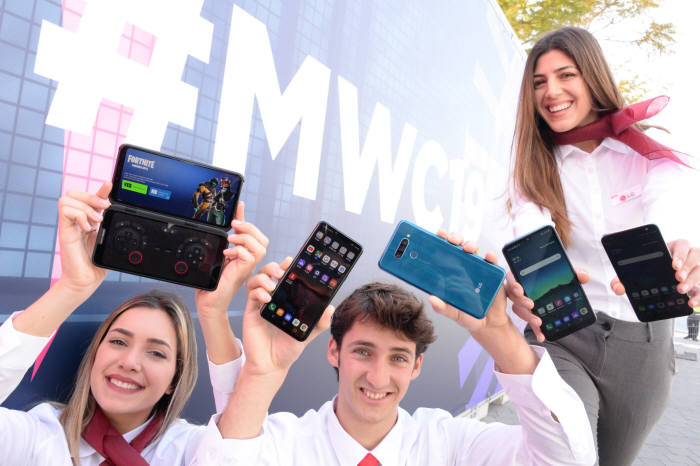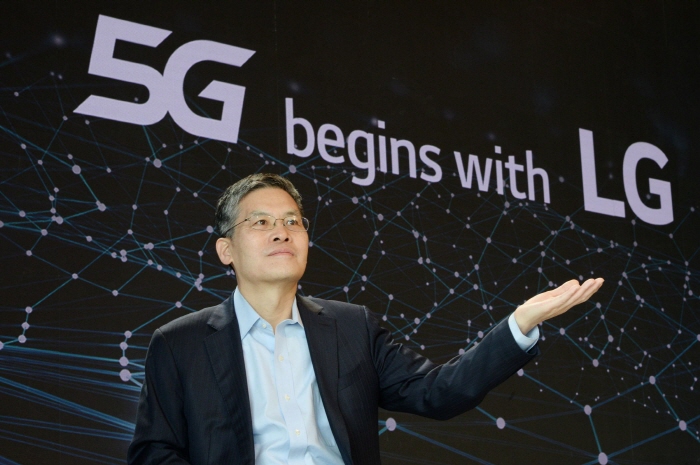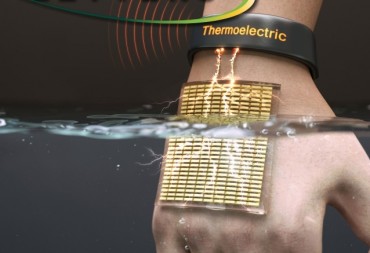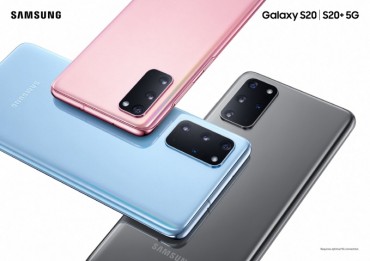
Models present LG Electronics Co.’s V50 ThinQ that supports 5G networks and comes with a detachable second screen and the 4G-based G8 ThinQ on the eve of MWC Barcelona on Feb. 24, 2019. (image: LG Electronics)
BARCELONA, Feb. 24 (Korea Bizwire) — LG Electronics Inc. introduced its first 5G smartphone with a detachable secondary screen and a 4G flagship model during a launch event in Barcelona on Sunday, joining the latest industry trend to showcase next-generation connectivity devices and new form factors.
The South Korean consumer electronics giant unveiled the V50 ThinQ that supports 5G networks alongside the 4G-based G8 ThinQ on the eve of the Mobile World Congress (MWC) Barcelona, the biggest mobile show of the year. The move highlights the company’s determination to turn the fate of its money-losing mobile business through innovation.
While LG previously launched the G series in the first half of the year and the V series in the second half, the company has changed its strategy this time around by launching them at the same time. The company hopes this will allow it to better position itself in the fast-changing mobile market.
The V50 is the company’s first 5G phone and is set to debut in time for the commercialization of the ultra-high-speed network in South Korea and the United States in the first quarter.
“LG’s first 5G handset will exceed expectations, offering uncompromising reliability, and allow users to experience high-quality content at 5G speeds that can deliver up to 20 times the speed of 4G,” LG said.
The handset maker introduced a dual screen as an optional accessory for the 5G model to double the screen real estate. This, it said, can enhance the gaming and multitasking experience of the device.
In select games, the dual screen can be used as a dedicated controller, resolving the problem of thumbs getting in the way of the action.
Qualcomm’s latest Snapdragon 855 chipset along with X50 5G modem will power the V50 to support high-resolution games and data-heavy applications without latency.
The phone with a 6.4-inch OLED full vision display is equipped with a 4,000 mAh battery, 20 percent larger than its previous model, and uses vapor chamber technology to better disperse heat that can impair the performance of the high-function phone.
LG said it will partner with 10 major carriers in major markets where 5G service will be launched this year, including the United States, South Korea, Australia and European countries.

Kim In-kyung, senior vice president and fellow of LG Electronics Inc., introduces the LG V50 ThinQ, its first 5G model with a detachable second screen, during a launch event held at the Barcelona International Convention Centre on Feb. 24, 2019. (image: LG Electronics)
During the event held at the Barcelona International Convention Centre with media representatives and global partners, LG also announced its 4G flagship model, the G8 ThinQ.
The G8 features a front-facing camera based on 3D technology that offers enhanced security and supports advanced applications while using time-of-flight (ToF) technology.
The 4G flagship phone utilizes its OLED display as an audio amplifier for better sound quality during playback.
G8 is the world’s first smartphone with advanced palm vein authentication, made possible by the combination of the ToF camera and infrared sensors.
It also features Air Motion, which allows users to answer calls, switch between applications or adjust the volume without touching the phone.
When a demonstrator showed the Air Motion gesture on the stage to open apps, play music and even adjust the volume with his finger above the phone, he received a big round of applause.
The device is also capable of reading blood vessels in a palm using infrared light to allow users to unlock their phones not with their face or fingerprint, but by holding a hand over its front-facing camera.
The launching date and prices of V50 and G8 were not immediately available. LG is expected to release the 5G model in March in South Korea in time for the commercial rollout of 5G network, with a higher price than its 4G flagship, but less expensive than Samsung’s Galaxy Fold and Huawei’s Mate X.
LG is the latest in a series of handset makers to go for a new form factor with a bigger screen to embrace the upcoming 5G era.
Earlier this week, market leader Samsung Electronics Co. made a splash with its first foldable phone with an almost US$2,000 price tag.
Just hours ahead of LG’s launching event, China’s Huawei showed off its folding device, and its rival Xiaomi also announced its own foldable model that supports 5G networks.
LG has struggled in the smartphone market for years as it has been sandwiched between Samsung Electronics and Apple in the high-end market and Chinese manufacturers in the lower-end segment. The mobile division has been posting losses since the second quarter of 2017.
The mobile communication division’s annual sales reached 1.7 trillion won (US$1.5 billion) last year but posted an operating deficit of 322.2 billion won due to gloomy sales of smartphones and increased marketing costs.
(Yonhap)






